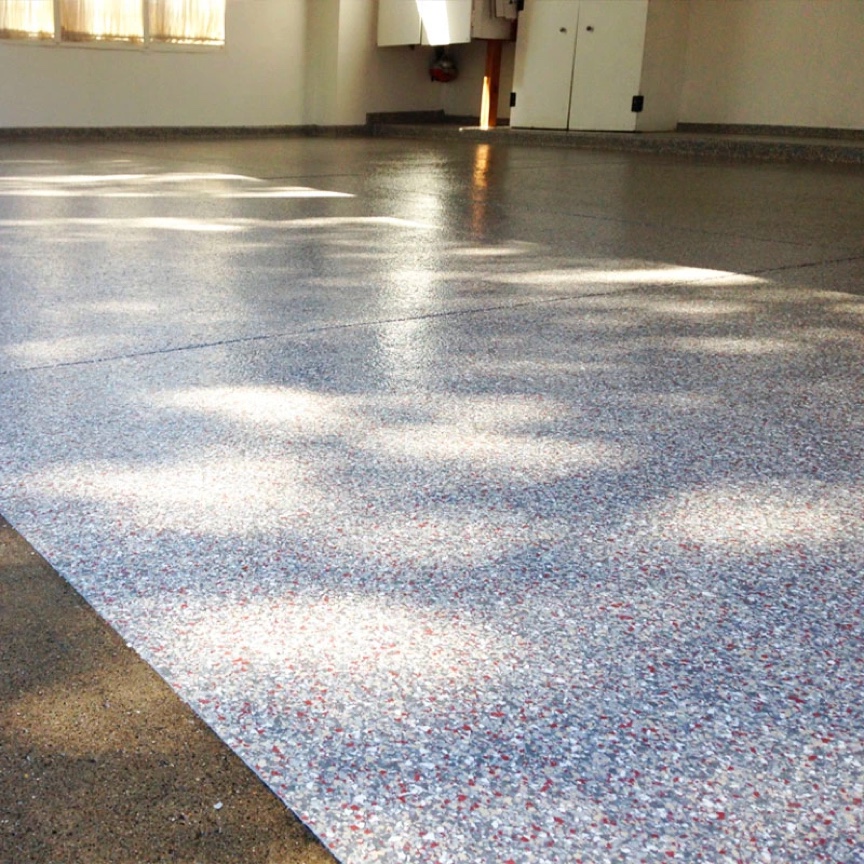
Are you tired of your dull and stained garage floor? Looking for a flooring solution that combines durability, style, and easy maintenance? Look no further than polyaspartic floor coating. In this blog post, we will explore the key benefits of polyaspartic floor coatings, debunk common misconceptions, and guide you through the process of choosing the right floor coating for your needs.
Understanding Polyaspartic Coatings: Composition and Features
If you're new to the world of garage floor coatings, you might be asking, "What exactly is a polyaspartic coating?" Well, let's dive in and unravel this superior flooring solution.
Polyaspartic coatings are a type of 2-component aspartic resin, a breakthrough technology that elevates flooring standards to unprecedented heights. The secret behind their unmatched durability and performance lies in their unique formulation. Comprising an aliphatic polyisocyanate and a polyaspartic ester – which is the resinous part – these coatings are engineered to withstand extreme conditions. They're not only resistant to abrasion, chemicals, and UV rays, but also exhibit excellent adhesion properties.
In layman's terms, think of these coatings as the protective armor for your garage floor, guarding against everything from tire marks to oil stains, and even offering remarkable resistance to yellowing from the sun. With polyaspartic coatings, you're investing in a product that offers both incredible strength and aesthetic appeal – a combination that's hard to find in today's saturated market.
The Advantages of Polyaspartic Floor Coatings
Polyaspartic floor coatings offer a perfect blend of durability and style for your garage floors. Here are some of the key advantages that make polyaspartic coatings stand out:
1. Unmatched Durability: Polyaspartic coatings are renowned for their exceptional durability. They can withstand heavy foot traffic, impact from dropped tools, and even harsh chemicals without showing signs of wear and tear. With a polyaspartic-coated garage floor, you can enjoy a long-lasting, resilient surface that will enhance the functionality of your space for years to come.
2. Rapid Curing Time: Unlike other floor coatings, polyaspartic coatings cure rapidly. Within just a few hours, the coating is fully cured and ready for use. This quick curing time minimizes downtime and allows you to return to your garage sooner.
3. Customizable and Aesthetic Appeal: Polyaspartic coatings offer a wide range of design options to suit your aesthetic preferences. From glossy finishes to a variety of colors and decorative flakes, you can customize your garage floor to create a unique and visually appealing space.
4. Easy Maintenance: Polyaspartic coatings have a smooth, non-porous surface that is resistant to stains and spills. Cleaning is a breeze, requiring only mild soap and water. Say goodbye to stubborn stains and tedious maintenance tasks.
5. Enhanced Safety: Perhaps one of the most significant advantages of polyaspartic floor coatings, and often the most overlooked, is the superior safety it provides, particularly in high-traffic areas. Thanks to its non-slip properties, polyaspartic coatings greatly reduce the risk of accidents caused by slipping, which is especially crucial in areas like your garage where oil spills or wet surfaces may be common. Moreover, these coatings are highly resistant to heat and impact, further ensuring the safety of your space. So, with polyaspartic coatings, you're not only investing in a floor solution that is stylish and durable, but also one that prioritizes safety.

Comparative Analysis: Polyaspartic vs. Other Floor Coatings
To make an informed decision, it's essential to understand the differences between polyaspartic floor coatings and other options such as epoxy, acrylic sealers, and urethane coatings.
- Epoxy Coatings: While epoxy coatings are known for their durability, they can take significantly longer to cure compared to polyaspartic coatings. Epoxy coatings are also more prone to yellowing over time.
- Acrylic Sealers: Acrylic sealers are a cost-effective option, but they offer less durability and are more prone to wear and tear. Polyaspartic coatings provide a more durable and long-lasting solution for your garage floor.
- Urethane Coatings: Urethane coatings have excellent resistance to chemicals, but they can be slippery when wet. Polyaspartic coatings offer a similar level of protection while providing a customizable, non-slip surface.
The Installation Process
The installation of a polyaspartic floor coating follows a straightforward process:
- Surface Preparation: The floor is thoroughly cleaned and prepared, which may involve grinding or shot blasting to create a suitable profile for the coating to adhere to.
- Crack Repair: Any cracks or holes in the floor are filled and smoothed out to create a seamless surface.
- Priming: A primer is applied to the floor to ensure strong adhesion of the polyaspartic coating.
- Coating Application: The polyaspartic coating is mixed and applied to the floor. Multiple layers are typically applied to achieve maximum durability and performance.
- Curing: Unlike other coatings, polyaspartic coatings cure rapidly, often within a few hours, allowing for quick return to service.
- Final Inspection: The floor is inspected to ensure complete coverage and proper application.
Please note that each installation may vary based on the specific conditions of your garage floor. Consulting with a professional installer will ensure the best results.
Real-Life Examples: Case Studies
To illustrate the benefits of polyaspartic floor coatings, let's take a look at some real-life examples:
- Case Study 1: A homeowner in Phoenix, Arizona, decided to upgrade his garage floor with a polyaspartic coating. Despite the extreme summer heat, the coating showed no signs of yellowing or peeling. The homeowner was impressed with the coating's resilience and the fresh, glossy look it maintained.
- Case Study 2: A car workshop in Chicago chose a polyaspartic floor coating for its durability and quick curing time. The quick turnaround minimized disruption to the business operation. Even under heavy traffic and contact with automotive fluids, the coating remained intact and easy to clean.
- Case Study 3: A family in Houston opted for a polyaspartic floor coating for their garage, which also doubled as a playroom for their kids. The non-slip finish of the coating enhanced safety, and the easy-clean properties made it a practical choice for a multi-purpose space.
Maintaining the Look: Tips for Cleaning and Caring for Polyaspartic-Coated Garage Floors
Even with superior resilience and stain-resistance, polyaspartic coatings benefit from regular maintenance to preserve their aesthetic appeal and functionality. Here are some practical tips to help you maintain your polyaspartic-coated garage floor:
1. Regular Cleaning: Use a soft bristle broom or a dust mop to keep the floor free from dust and small debris. For a thorough clean, a damp mop with a mild, pH-neutral cleaning agent can be used. Avoid using harsh chemicals, which may damage the coating over time.
2. Prompt Spill Clean-Up: While polyaspartic coatings are highly resistant to chemical spills, it's still a good idea to clean up spills promptly. This not only maintains the floor's aesthetic appeal but also extends the life of the coating.
3. Protective Measures: If you're moving heavy machinery or equipment, consider using protective mats or plywood to distribute the weight evenly and prevent potential scratches. While polyaspartic coatings are scratch-resistant, such measures can add an extra layer of protection.
4. Regular Inspection: Periodically inspecting the floor can help identify any minor issues before they escalate into major problems. Look for signs of wear, scratches, or changes in color.
5. Professional Maintenance: Depending on usage, consider having a professional floor maintenance service every few years. They can perform a deeper clean and repair any minor damages, guaranteeing the longevity of your polyaspartic-coated garage floor.
By following these maintenance practices, you can ensure that your polyaspartic-coated garage floor remains durable, aesthetically pleasing, and performing optimally for many years to come.
The Cost of Polyaspartic Floor Coatings
When considering a polyaspartic floor coating, it's vital to recognize its long-term value. While the initial cost might seem higher compared to other coating options, the unique benefits of polyaspartic coatings — such as superior durability, rapid curing time, aesthetic appeal, and easy maintenance — make it a cost-effective choice over time. Unlike other coatings that might require regular touch-ups or replacements, a polyaspartic floor coating is a long-term investment that sustains its quality and performance over the years. Just imagine the exceptional resistance to wear and tear, the hours saved due to its fast-curing nature, and the reduction in maintenance costs. Isn't it worth considering? Reach out to us for a consultation and quote customized to your specific garage flooring needs.
Conclusion
Polyaspartic floor coatings offer a winning combination of durability, style, and low maintenance for your garage floors. With their rapid curing time, customizable designs, and long-lasting performance, they are an excellent investment for homeowners seeking a functional and visually appealing garage space. When considering floor coatings, it's essential to compare options, understand the installation process, and consult with professionals to ensure the best results. Upgrade your garage with polyaspartic floor coatings and enjoy a beautiful, resilient, and easy-to-maintain floor for years to come.
Frequently Asked Questions
1. What are polyaspartic floor coatings?
Polyaspartic coatings are a type of high-performance floor coating known for their exceptional durability, rapid curing time, and aesthetic versatility. Developed from aliphatic polyurethane technology, they provide superior resistance to wear, tear, stains, and chemicals.
2. How do polyaspartic coatings compare to epoxy, acrylic, and urethane coatings?
While epoxy, acrylic, and urethane coatings each have their merits, polyaspartic coatings offer distinct advantages. Compared to epoxy, they cure more rapidly and resist yellowing. They provide greater durability than cost-effective acrylic sealers, and unlike urethane coatings, they offer a non-slip surface customizability, in addition to excellent chemical resistance.
3. What is the installation process for polyaspartic floor coatings?
The installation process typically involves surface preparation, crack repair, priming, coating application, quick curing, and a final inspection. The exact process can vary based on the specific conditions of your garage floor, so it's recommended to consult with a professional installer.
4. Are polyaspartic coatings costly?
The initial cost of polyaspartic coatings might be higher than other options, but their long-term value makes them a cost-effective choice. Their superior durability, rapid curing, attractive aesthetics, and easy maintenance mean fewer touch-ups or replacements over time, saving you money in the long run.
5. How do I maintain a polyaspartic-coated floor?
Polyaspartic-coated floors are easy to maintain. Their smooth, non-porous surface resists stains and spills. Routine cleaning requires only mild soap and water, making it easy to keep your floor looking its best.

